
APS
ARCHÄOLOGISCHER PARK SCARBANTIA
 |
SCARBANTIA RÉGÉSZETI PARK
APS ARCHÄOLOGISCHER PARK SCARBANTIA |
SCARBANTIA KÖZPONTJA. A FÓRUM ÉS KÖRNYÉKE.
Sopron római kori városelődje,
Scarbantia oppidum először Plinius (Historia naturalis III.14.)
cca 50-77 között írott munkájában van említve. A korai római császárkorban
még nyílt település, amely az Ikva és Rák patakok között helyezkedett el
a Flaviusok alatt lendült nagyobb fejlődésnek — amikor több felíratos kőemlék
tanúsága szerint — megkapta a municipiumi rangot MVN(icipium)
FL(avium) SCARB(antesium). Ekkor kezdik itáliai minták alapján
kiépíteni a város központját. A fórum nagy építkezései Traianus
(98-117) és Hadrianus (117-138) uralkodása alatt folytak.
A Fő téren a Gambrinus és a Patika ház közötti sikátorban látható a
Borostyánkő út egy szakasza. A Ferences (Bencés, Kecske-) templom előtt
a burkolatban egy későrómai horreum, magtár alaprajzát jelölték a műemléki
rekonstrukciók során.
A fórumtól indultak a távolsági utak minden irányba, illetve helyesebben a fórumot a főutak találkozásánál alakították ki. A városfejlődés virágkora a municipiumi rang adományozása utáni időszakra, az I. sz. végétől a II. század első feléig, főleg Traianus uralkodásának első évtizedeire esett. Ehhez hozzájárulhatott, hogy a későbbi császár, Traianus a 90-es években pannóniai helytartó volt és a Scarbantia melletti Savariában tartózkodott. Másrészt a provincia kettéosztása, 106 után a carnuntumi helytartó közelsége fontos volt Scarbantia városfejlődése szempontjából. 137-ben, Hadrianus uralkodása idején éppen egy igen befolyásos személyiség, a császári utódnak jelölt L. Aelius Caesar volt Pannonia Superior helytartója. Néhány kutató feltételezi, hogy az ő carnuntumi tartózkodása idején szállították Scarbantia fórumának újjáépített capitoliumi templomába a monumentális, fehér márvány istenszobrokat. Helytartók gyakran megfordulhattak Scarbantiában. 300 körül — valószínűleg már a Scarbantiai városfalak építésének időszakában — Amantius, Pannonia prima praesese akkor járt a városban, amikor elé állították Szt. Quirinus sisciai püspököt. A Szt. Quirinus vértanúságáról szóló passió (a vatikáni 1191. számú latin kódex) szövege említi, hogy a praeses a püspököt Savariába küldte vissza kihallgatás céljából.
Miután a IV. század elején, birodalmi staratégiai elvek szerint, a Sirmium melletti Bassiana, illetve a Trier melletti Beda (Bitburg) városfalaihoz hasonlóan a Savaria melletti Scarbantiában is felépítettek egy úti erődöt — a város egy részét városfallal körülvéve — a város fórumától kivezető utakat K-i és Ny-i irányban eltorlaszolták. Kaput csak É-i és D-i irányba építettek. Az É-i kapu tornyai a Borostyánkő út részletével a Várostorony melletti védőépület alatt láthatók. A fórum háztömbjének észak-keleti sarka a római úttal és a városfalakkal a Scarbantia Régészeti Park területén, a Városháza mögött tekinthető meg. A későrómai korban hypocaustumos helyiségeket emeltek a fórumon, a Curia mellett. Ugyanitt terrazzó padlójú, de deszka falú bódékat, valószínűleg üzleteket is építettek. A városfalak mellé helyenként padlófűtéses helyiségeket ragasztottak, a fórum szomszédságában.
Városfalak megépítése után,
egy korábbi szentély helyén építették fel a horreumot, amely a fórumtól
Ny-ra (ez a mai Fő tér területén) állott. A horreum alaprajzának
részlete a tér burkolatában kaviccsal kirakva látható.
A fórum környékéről összefoglaló áttekintést Fórum Múzeumban és a Soproni
Múzeum Régészeti Gyűjteményében kaphat a látogató.
Museum Sopron
Ausstellungen:
„Jahrtausende an der Bernsteinstraße"(Archäologische
Ausstellung), Römisches Lapidarium
(Sopron, Főtér 6)
Die archäologische Dauerausstellung des Museums
von Sopron wurde im Jahre 1999 eröffnet, nur einige Meter von den freigelegten
Resten der jahrtausendealten Handelsstraße entfernt, die das Adriatische
Mehr und die Bernsteinlagerstätten am Baltischen Mehr miteinander verband.
Die Ausstellung zeigt die wichtigsten Funde der
beiden letzten Jahrzehnte und die europaweit berühmten früheren Funde der
Sammlung. In fast allen sieben Sälen befinden sich archäologische Kunstgegenstände,
die für die Forschung der verschiedenen Perioden maßgebend waren und des
öfteres verliehen wurden, um auch in größeren ausländischen, europaweiten
Ausstellungen dargestellt zu werden.
Im schönsten gotischen Bürgerhaus der Stadt,
im Haus Fabricius
an der mittelalterlichen Stadtmauer wurde ein archäologisches Museum eingerichtet
und zeigt jede Ära betreffend die weiten Einflüsse. Die für Sopron und
ihre Umgebung, sowie die Siedlungen an der Bernsteinstraße maßgebend waren.
In den Sälen III und IV kann die Vorgängerin
von Sopron aus der Römerzeit betrachtet werden. Die ersten Hinweise auf
Oppidum Scarbantia Julia stammen aus der Zeit des Kaisers Tiberius
(14-57). Anstelle der früheren Holz- und Lehmbauten wurden in Scarbatia
in der zweiten Hälfte des l. Jahrhunderts Steinhäuser errichtet. Den Stadtrang
(Municipium Flavium Scarbantiensium) erwarb die Siedlung im letzten
Drittel des l. Jahrhunderts. Die Baureste und behaute Steine, die in der
Stadt aufgefunden wurden, können vor der pompeiiroten Wand betrachtet werden.
Die Ausstellung verfügt desweiteren über die
Ausgrabungsdokumente des einzigen typischen römischen Forums Ungarns, sowie
über Freilegungsergebnisse eines Amphitheatrums und Bades aus dem 2. Jahrhundert.
Die rekonsturierten
Teile des südlichen Friedhofes von Scarbantia stellen verschiedene
Bestattungsweisen dar. In einer Sondervitrine wurden die kunstvoll bearbeiteten
Bernsteinschmuckstücke
ausgestellt. Prachtstücke des römischen Kunsthandwerks sind Gläser, Gegenstände
aus Bronze und Keramiken, unter anderem herrliche terra sigillate Gefässe,
die in Gräbern von Scarbantia aufgefunden wurden.
Die Festung für Straßensperrzwecke, die während
der Zeit von Diocletianus (284-305) errichtet wurde, unter den Stadtmauern
um die heutige Innenstadt war bis zum Jahre 568, bis zum Auszug der Langobarden
nach Italien bewohnt. Archäologische Ausgrabungen führten zur Freilegung
einer Langohard S-Fibel in der Räumlichkeit mit Ziegelboden und altchristlichen
Darstellungen am Forum von Scarbantia. Die alte römische Festung war von
der Awarenzeit bis zum 10. Jahrhundert unbewohnt.
| Öffnungszeiten: | April- September | 10-18 Uhr |
| Oktober-April | l0-l4 Uhr | |
| Eintrittspreis | Erwachsene | 300 Ft. |
| Studenten | 150 Ft. |
Museum of Sopron
Places of exhibition:
"Millennia along the amber
road" (Archaeological exhibition), Roman Lapidary
(Sopron,
6. Fő square)
The permanent archaeological exhibition of the
Museum of Sopron opened in 1999, a few meters from the remnants of the
thousands of years old commercial road connecting the areas of the Adriatic
Sea with the amber sites of the Baltic Sea, that were uncovered in Sopron's
Fő square.
At the exhibition the outstanding findings uncovered
in the last two decades can be seen together with the old ones that are
well-known across Europe. There is an archaeological object of art in almost
all of the seven rooms of the exhibition that is of major importance in
the study of a period, and as a rental object it is often "guest" of European-scale
exhibitions displaying great foreign collections.
The archaeological museum furnished in the town's
most beautiful Gothic civil house, the Fabricius-house
built next to the medieval town wall, presents those distant influences
in periods that played a significant part in the life of Sopron and its
surroundings, and that of the settlements along the Amber Road. The Roman
ancestor of the town of Sopron is shown in rooms III and IV of the exhibition.
The first mentioning of Oppidium Scarbantia Julia is known from
the age of Emperor Tiberius (14-57). In the place of the former
wooden and adobe houses, they begun to build stone houses in the second
part of the 1st century in Scarbantia as well. It received town rights
(Municipium Flavium Scarbantiensium) in the last third of the 1st
century. The architectural fragments and carved stones that were found
in the city are exhibited in front of a Pompeii red painted wall. We show
the excavation documents of the only typical Roman forum found in the territory
of Hungary, and the results of the uncovering of the municipium's 2nd century
amphitheatre and bath. The reconstruction
of an uncovered part of the southern graveyard of Scarbantia inform
the visitors about the various buried customs. The artistically carved
amber jewels can be found in separate showcase. The glasses, bronze
objects and ceramics, and among them the terra sigillata vessels found
in the graves of Scarbantia are the masterpieces of the Roman handicrafts.
The road-blocking fort of Scarbantia built in
the age of Emperor Diocletianus (284-305) - within the town-walls
surrounding today's city centre of Sopron (568), was inhabited until the
Lombard people's moving into Italy. The archaeological excavations uncovered
a Lombard S-fibula in the floor-bricked room preserving Old-Christian portrays
next to the forum of Scarbantia. The old Roman fort was uninhabited from
the Avar Age up to the 10th century.
| Opening hours: (Except Monday) | April- September | l0:00 am – 18:00 pm. |
| October - April | 10:00 am – l4:00 pm. | |
| Tickets: | Adults | 300 Ft. |
| Students | 150 Ft. |
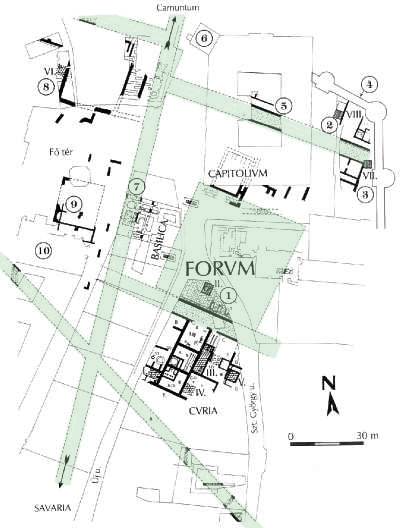 |
JELMAGYARÁZAT :
1. A Fórum Múzeum, FORUM SCARBANTIAE
|
IRODALOM Scarbantia úthálózatához és a római város központjához:
Gömöri J., Municipium Flavium Scarbantia, Nuovi scavi in una citta
comerciale situata la via dell' ambra, In: La Venetia nell' area Padano
Danubiana, (Red. Massimiliano Pavan, Guido Rosada...), Padova 1990, 401
417.
GÖMÖRI J., Recent Archaeological Finds Concerning the Topography
of Scarbantia. in: La Pannonia e l'Impero Romano. Annuario dell’Academia
d’Ungheria, Roma 1994. 251-261.
Gömöri János: Archäologische Daten zur Topographie Scarbantias.
Römische Baudenkmäler im Stadtbild von Sopron. Scarbantia/Sopron városrégészeti
kutatása. In: The Amber Road. A Borostyánkő út. Die Bernsteinstrasse. (Szerk.:
Gömöri J.) Sopron, 1999. 94-116.
Póczy Klára: Scarbantia. A római kori Sopron. (Sopron in the Roman
Period). Budapest 1977.
Póczy K.: Die Anfänge der Urbanisation in Scarbantia, ActaArchHung
23. (1971) 73 110.
Póczy K.: Városépítés Pannoniában. Építés, Építészettudomány 5.
(1974) 151-165.
Póczy K.: Städtebau in Pannonien. Neue Forschungen in Carnuntum.
Band 1. Wien 1976, 95-113.
Póczy K.: Scarbantia önkormányzatának tevékenységéről. Über die
Tätigkeit der Selbstsverwaltung von Scarbantia. In: Tanulmányok Csatkai
Endre emlékére. Sopron 1996. 17-26.
FORUM SCARBANTIAE (Scarbantia fóruma)
Scarbantiát, mint oppidumot Kr. u. 15.-ben említi először ifjabb Plinius. A város 80 körül municipiumi rangot kapott. Ekkor kezdték kiépíteni a fórumát, amely csak Trajanus (87-117) és Antoninus Pius (136-161) császárok uralkodása közötti időben épült ki teljesen. A II. századi római kori fórum egyedülálló Pannóniában. Részletét szabadtéren a városháza mögötti régészeti parkban láthatjuk. Itáliai mintára épült fórumunk Déli része a római városházával, a curia-val az Új. u. 1. száma alatt (AXA biztosító) tekinthető meg. A fórum északnyugati sarkánál (a mai városháza 1894-95. évi építésekor) tárta fel Bella Lajos a capitoliumi templom maradványait. Ennek monumentális szobrai a Fabricius ház kőtárában (Fő tér 6. Régészeti Gyűjtemény) láthatók. A városháza sarkától kiindulva egy a burkolatban jelzett vonal jelöli a forum Ny-i szegélyét, a basilica, a törvénykezés házának lépcsősorát, amely a tér alatt négy és fél méter mélyen található.Ez egy oszlopcsarnokos pódiumépület volt. A tér keleti részét padlófőtéssel ellátott, emeletes épület zárta le.
Részleteiben tipikus itáliai fórumot építettek, amelynek
alaprajza viszont inkább a görög agora négyszögletes
formáját idézi. A fertőrákosi lajtamészkő lapokkal burkolt tér területe
45x46 m. Gondosan faragott, nyitott esővíz-elvezető csatorna határolja
a teret, amelynek D-i oldalán oszlopcsarnok emelkedett, a porticus mögött
állt a curia, a városháza. A
tér déli szélén három lovas-szobor alapzata is előkerült. Ezeken valószínűleg
császárok életnagyságú bronzszobrai álltak. A fórum 1979-1988 között feltárt
déli része látható az 1994-ben megnyitott kiállításban (rendezte: Gömöri
János).
FÓRUM MÚZEUM RÉGÉSZETI KIÁLLÍTÁS
FORUM SCARBANTIAE, ARCHÄOLOGISCHE AUSSTELLUNG,
ARCHAEOLOGICAL EXHIBITION
Sopron, Új u. 1.
NYITVA - GEÖFFNET - OPEN:
| H-CS, | M-D, | M-Th: | 8-16 h |
| P, | Fr, | Fr: | 8-13 h |
| Szo-V, | Sa-So, | Sat-Sun: | 10-17 h |
Jegyváltás /Ticket/:
H-P, M-Fr, M-Fr:
Axa Biztosító iroda, Új u. 1. (Tel.: 99/321-804)
Szo-V, Sa-So, Sat-Sun:
Napóleon Pince, Új u. 4. (Tel.: 99/320-743)
Jegyváltás a az AXA Biztosító
irodában. Belépődíj 240.- Ft, nyugdíjas és diák 120.- Ft.
SCARBANTIA- szakvezetést csoportoknak a Fórumon és a római kori
város maradványainak
megtekintésére a Scarbantia Régészeti Park Alapítvány biztosít,
előzetes telefonos egyeztetés alapján:
0620 364-2263
Führung in der römischen Stadt
Guide in the Roman Town
0620 364-2263
FORUM SCARBANTIAE (Scarbantia fóruma)
Forum Scarbantiae (Das römisches Forum) (Sopron,
Új u. 1, Kellergeschoß)
Forum Scarbantiae (The Roman Forum) (Sopron,
1 Új street, in the building's basement)
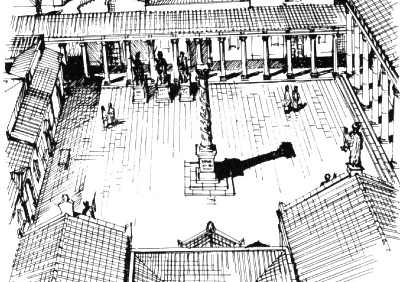
Forum Scarbantiae:
Die Vorgängerin der Stadt aus der Römerzeit,
Scarbatia oppidum war im l -3. Jahrhundert noch eine offene Siedlung zwischen
den Bachern Ikva und Rák. Während der Flaviuszeit erhielt die Stadt den
Municipiumrang MVN(icipium) FL(avium) SCARB(antiensium). Zu dieser
Zeit wurde mit den Ausbauten des Stadtzentrums nach italienischem Muster
begonnen. Die bedeutenden Bauarbeiten wurden auch während der Zeit von
Traianus (98-117) und Hadrianus (117-138) fortgesetzt. Es
wurde ein typisches italienisches Forum gebaut, jedoch mit einem Grundriß,
der viel mehr an die viereckige Form des griechischen Agoras schließen
läßt. Der Platz von 45x46 m wurde mit Kalksteinen aus Fertőrákos belegt.
Umgegrenzt wird der Platz von einem gründlich behauten Kanal für Niederschlagableitung,
an der südlichen Seite stand eine Säulenhalle, und hinter dem Porticus
stand die Curia, das Rathaus. An der südlichen Seite des Platzes
wurden Fundamente von drei Reiterstatuen freigelegt. Auf diesen Fundamenten
standen wahrscheinlich Bronzestatuen ehemaliger Kaiser in Lebengröße. Am
westlichen Teil des Forums wurde ein Podiumgebäude mit Säulenhallen, die
Basilica (Haus der Gesetzgebung) errichtet. Am östlichen Teil stand
ein mehrstöckiges Gebäude mit Bodenheizung. An der nordöstlichen Ecke des
Forums wurden vom Archäologen Lajos Bella (während der Bauarbeiten des
heutigen Rathauses zwischen 1894 und 95) Reste einer während der Zeit von
Antoninus Pius (138-161) renovierten Capitolium-Tempel aufgefunden,
mit monumantalen Götterstatuen
aus weißem Marmor.
Nachdem am Anfang des 4. Jahrhunderts den strategischen
Richtlinien des Reiches entsprechend Stadtmauern in Bassiana bei
Sirmium. bzw. Beda (Bitburg) bei Augusta Treverorum
(Trier) errichtet wurden, wurde auch in Scarbantia bei Savaria
eine Festung gebaut - und so um einen Teil der Stadt Stadtmauern errichtet
- und die Straßen, die aus dem Forum der Stadt führten, wurden östlich
und westlich versperrt. Tore wurden nur nördlich und südlich gebaut. Die
Türmer des Nordtores und ein Teil der Bernsteinstraße können unter dein
Schutzgebäude am Stadtturm betrachtet werden. Die nordöstliche Ecke des
Gebäudeblocks am Forum sowie die römische Straße und die Stadtmauern können
im Archäologischen Park von Scarbantia hinter dem Rathaus bewundert werden.
Das zwischen 1979-1988 freigelegte südliche Teil
des Forums kann im Forum Museum betrachtet werden, das im Jahre 1994
eröffnet wurde.
Forum Scarbantiae
The Roman ancestor of the town of Sopron, Scarbantia
oppidum was still an open settlement in the 1st - 3rd centuries situated
between the streams Ikva and Rák. Under the Flaviuses Scarbantia received
the title of municipium MVN(icipium) FL(avium) SCARB(antiensium)
. The building of the town's centre at the meeting of the main roads on
the basis of Italian patterns was begun at this time. The great constructions
of the Forum were continued under the reign of Emperor Traianus
(98-117) and Emperor Hadrian (117-138). A typical Italian forum
was built, the ground-plan of which, however, rather resembles the rectangular
form of the Greek agora. The area of the square covered with plates of
lime stone is 46x46 m. On the southern edge of the square stood a portico,
and behind life portions was the curia, the town hall. The plinths
of three equestrian statues were also found on the southern side of the
square. Probably life-size bronze statues of emperors stood on these, A
podium building with portico, the basilica (house of jurisdiction)
was on the western side of the square. The eastern side of the square was
closed by a storied building provided with floor-heating. It was the archaeologist,
Lajos Bella who uncovered the remnants of tlie temple of Capitolium
that was rebuilt under Antoninus Pius (138-161), together with the monumental
white marble God statues
of the Capitolium, at the north-western corner of the forum
(in the course of the construction of today's town hall in the years 189
-95). When in the beginning of the 4th century according to imperial strategic
principles, similarly to the town walls of Bassiana that was next
to Sirmium, and Beda (Bitburg) that was next to Augusta
Treverorum (Trier), a new to tress was built along the road in Scarbantia
that was next to Savaria as well - surrounding a part of the town
by a wall, and blocked the roads that were leading out of the town in eastern
and western direction. Gates were built only in the northern and southern
directions. The towers of the northern gate together with a part of the
Borostyánkő (amber) road can be seen under the defensive building beside
Town Tower (Várostorony). The north-eastern corner of the forum's building
with the Roman road and the walls of the town can be seen behind the Town
Hall. The southern part of the forum uncovered between 1979-1988 can be
seen in the Forum Museum opened in 1994.
IRODALOM Scarbantia fórumához:
Gömöri János.: Scarbantia Foruma. Il foro di Scarbantia. Bp. 1993.
TKM 455. Ders.: Das Forum von Scarbantia. The forum of Scarbantia. TKM
455/A. Bp. 1993.
Gömöri J.: Scarbantia foruma. Das Forum von Scarbantia. Soproni
Szemle kiadványai. Új sorozat. 14. 1985, és Soproni Szemle 1985,
1-24. 97-118. 193-212. 289-298.
Gömöri J., Grabungen auf dem Forum von Scarbantia (1979 1982.),
Acta. Arch. Hung. 38, 1986, 343 396.
Gömöri J., Neue Erkentnisse zur Topographie des Forums in Scarbantia,
Carnuntum Jahrbuch 1991 (1992), 57 70.
Póczy Klára: Scarbantia. A római kori Sopron. (Sopron in the Roman
Period). Budapest 1977.
Szakál Ernő: Jupiter, Juno és Minerva scarbantiai szobrai a Fabricius
ház kőtárában (Die Jupiter, Juno und Minerva Statuen aus Scarbantia im
Lapidarium des Fabricius Hauses), Magyar Műemlékvédelem 1973-74. (1977),
47 63.
RÓMAI KORI ROMKERT
Römischer Ruinengarten
The Roman ruins of Scarbantia
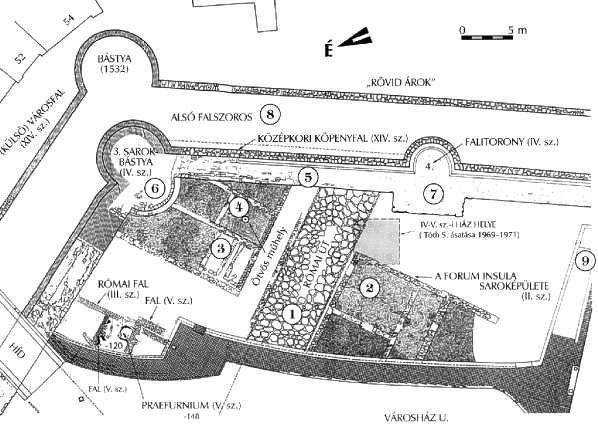
| RÓMAI KORI ROMKERT
II. SZÁZADI ÚT A FORUM-INSULA É-K-i sarka IV. SZÁZADI VÁROSFALAK XI. SZÁZADI SÁNC REKONSTRUKCIÓJA XIV. SZÁZADI VÁROSFALAK Az 1970-1980-as években folytatott feltárások a flaviusi Scarbantia
municipium fórumának saroképületét, a fórumot É felől határoló II. századi
utat és lakóépületek maradványait hozták felszínre. Az 5 méter széles tipikus
városi utat gneisz kövekkel bogárhátúra burkolták az esővíz elvezetése
miatt. Az út É-i oldalán padlófűtéssel ellátott és díszes freskók-
|
JELMAGYARÁZAT / :
1. Római út. / Römische Stadtstrasse. / Roman street. 2. Forum-insula ÉK-i sarka. / NÖ-Ecke des Forum-insula. / NE-corner of the Forum-insula. 3. Lakószoba padlófűtéssel és fali freskókkal. / Wohnzimmer mit Bodenheizung und Fresken. / Livingroom with hypocaustum and wallpaintings. 4. Bronzműves műhelye. / Bronzewerkstatt. / Bronze workshop. 5. Római városfal, IV. sz. / Römische Stadtmauer, 4. Jh. / Roman town wall, 4th cent. A.D. 6. A IV. századi római erőd kerek saroktornya. / Rundförmiger Eckturm der römischen Befestigungsmauer. / Circular tower at the NE-corner of the Roman fortification, 4th cent. A.D. 7. A IV. századi római erőd patkóalakú falitornya. / Hufeisenförmiger Mauerturm der römischen Befestigungsmauer. / Horseshoe shaped tower of the Roman fortification, 4th cent. A.D. 8. Középkori városfalak, XIV. sz. / Mittelalterliche Stadtmauern und untere Zwinger, 14. Jh. / Medieval Town walls, 14th cent. 9. XI. századi ispáni vár sánca. / Der Holzkonstruktion des frühungarischen Gespansburgs, 11. Jh. n. Chr. / Timber construction of the Early Hungarian Castle, 11th cent. A.D. |
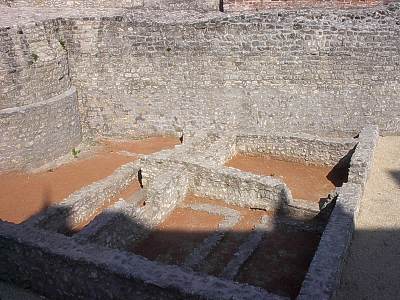 3. Lakószoba padlófűtéssel és fali freskókkal. / Wohnzimmer
mit Bodenheizung und Fresken. / Livingroom
with hypocaustum and wallpaintings.
|
|
IRODALOM a Scarbantia Régészeti Parkhoz, a középkori és a római
kori városfalakhoz és a Városház utcai romkerthez:
Gömöri János: Archäologische Daten zur Topographie Scarbantias.
Römische Baudenkmäler im Stadtbild von Sopron. Scarbantia/Sopron városrégészeti
kutatása. In: The Amber Road. A Borostyánkő út. Die Bernsteinstrasse. (Szerk.:
Gömöri J.) Sopron, 1999. 94-116.
Holl Imre: Sopron középkori városfalai. I. Archaeologiai Értesítő
94. (1967) 155-183., II. Arch. Ért. 95. (1968) 188-204., III. Arch. Ért.
98. (1971) 24-42., IV. Arch. Ért. 100. (1973) 203-206.,
Holl Imre: Sopron (Ödenburg) im Mittelalter. Archäologisch-stadtgeschichtliche
Studie. Acta Archaeologica Hung. 31. (1979) 105-145.
Holl Imre: Feuerwaffen und Stadtmauern. Acta. Arch. Hung. 33. (1981)
201-243.
Holl Imre, The Development and Topography of Sopron in the Middle
Ages. In: Towns in Medieval Hungary. ed. L. Gerevich Bp. 1990. 96-102.
Holl Imre, Scarbantia- Sopron városfalai. Soproni Szemle 51. (1997)
289-306.
Kissné Nagypál Judit, Sopron Városfalairól. Magyar Műemlékvédelem
1973-1974. Budapest 1977, 87-124.
Póczy Klára: Scarbantia városfalának korhatározása. Arch. Ért.
94. (1967) 137-
Póczy Klára: Scarbantia. A római kori Sopron. (Sopron in the Roman
Period). Budapest 1977.
A SOPRONI XI. SZÁZADI SÁNC REKONSTRUKCIÓJA
Der Holzkonstruktion des frühungarischen
Gespansburgs, 11. Jh. n. Chr.
Timber construction of the Early
Hungarian Castle, 11th cent. A.D.
Sopron Árpád-kori vára, ahogy a legkorábbi oklevelek említik: castrum
Supron az első magyar király, Szent István uralkodásának első éveiben,
1000 körül épült a IV. századból romosan megmaradt római kori erődítmény
falait felhasználva. A fontos határvár egyben ispáni központ, Sopron
vármegye központja is volt. Ez a XI. századi erődítmény a korabeli várépítési
technikának megfelelően összeácsolt fagerendákból készült, a fakazetták
belsejét földel töltötték fel. A sánc gerendaszerkezetéhez 16527
m3 fát és 53529 m3 földet használtak fel. A vársánc
leégésekor a 20 méter széles és kb. 8 méter magas földtöltés vörösre égett.
A soproni Árpád-kori sáncot 1895 óta kutatják a régészek, eddig 20
helyen végeztek rajta ásatásokat. A hiteles régészeti megfigyelések alapján
készült a részleges rekonstrukció, amely a sánc faszerkezetét mutatja.
A sánc tetejére a XIV. században építették a belső városfalat, amely most
metszetben látszik a rekonstruált sáncrészlet felett. A városfal alapozási
előugrása mutatja a sánc egykori magasságát.
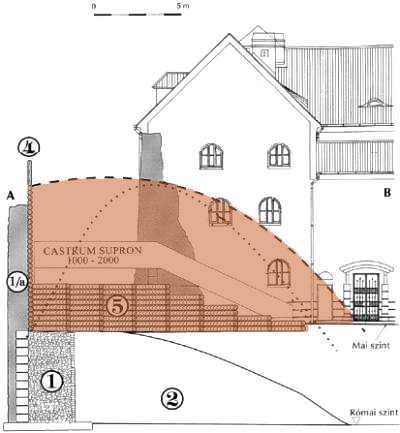 |
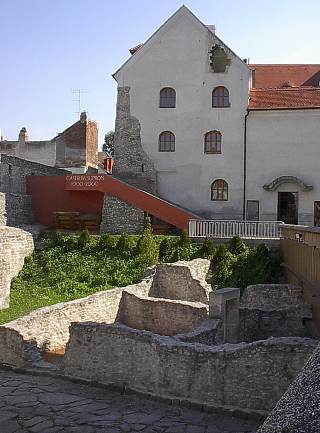 |
| 1. Római városfal IV. sz.(1/a fölötte a középkori
városfal, XIV. sz.)
Römische Stadtmauer, 4. Jh. / Roman town wall, 4th cent. A.D. 2. Római feltöltés a római út fölött 3. XIV. századi belső városfal
4. A leégett Árpád-kori sánc mellvédje (rekonstrukció) 5. A sáncszerkezet műemléki bemutatása (XI. század)
- - - A sánc feltételezhető eredeti vonala . . . . Sánc vonala a leégés után |
|
IRODALOM a XI. századi ispáni vár sáncához:
Gömöri János: Castrum Supron. Sopron vára az Árpád-korban. Der Burg
von Sopron (Ödenburg) in der Árpádenzeit. Sopron 2002. 26. kép.
(nyomdában, megjelenik 2002. őszén)
Nováki Gyula- Sándorfi György: Untersuchungen der Struktur des Ursprungs
der Schanzen der frühen ungarischen Burgen. Acta Archaeologica Hung. 33.
(1981) 133-160.
Nováki Gyula- Sándorfi György: A soproni belváros „vörös sánca”
kutatásának eredményei. Soproni Szemle 41. (1987) 38-43.
Tomka Péter, A soproni vörös sánc kutatása. In: Magyar Műemlékvédelem
1973-1974. Budapest 1977. 65-86.
Írta és összeállította: Gömöri János PhD, ásatásvezető
(Soproni Múzeum, Régészet), Scarbantia Társaság elnöke
Szerkesztette: Varga Gábor, (Nyugatmagyarországi Egyetem),
Scarbantia Régészeti Park Alapítvány kuratóriumának elnöke
Szponzor: Mestervonal Kft.
A városfalak műemléki helyreállításának tervezőmérnöke: H. Vladár Ágnes
© Gömöri János PhD
e-mail: gomori@ggki.hu
Az anyag másolása, sokszorosítása, felhasználása kizárólag a szerző
engedélyével lehetséges.
WEB változat: Tóth Éva -ISE